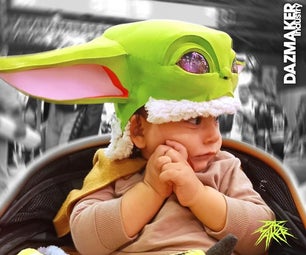Introduction: Mycographs
Mycographs involve the process applying yeast to an agar mold that is exposed to UV light to produce an image. This method is similar to screen-printing. We make a mold of agar media, and cover it in yeast. We then print a negative image on transparency paper to cover the mold. The image is exposed in a dark room to UV light for 48 to 72 hours. Where the light passes through, the yeast is killed. What we are left with is a living image grown in the shadow of the transparency print.
Supplies
For mixing 1L of culture media
- 10g Marmite
- 10g Beef Bouillon
- 20g Sugar
- 1.3g Activated Charcoal
- 150g Agar Agar
- 1L Distilled Water
For 250ml of yeast solution
- .13g of Instant Yeast
- 250ml distilled water
Image Making Materials
- Transparency Sheets 11x17
- Foam Core Board Frame 20"x30"
- Push Pins
Light Box Materials
- x2 38 gallon Storage Box
- x4 M6 1.0x40mm Philips Machine Screws
- x2 M6 1.0 Zinc-Plated Steel Machine Nuts (2 per pack)
- Meat Thermometer
- 18 Gauge Aluminum Hobby Wire
- Black Gorilla Tape
- Portable Necklace Fan
- 50watt UV Lamp
Step 1: Assemble Lightbox
The mycograph will cultivate in an assembled lightbox with two plastic totes. First, drill 4 holes at the bottom of your first tote where the corner of your UV light will be suspended. Insert 4 M6 machine screws into the holes. Be sure the head of the screws are inside the box. Secure the M6 machine screws to the storage box by threading 4 M6 Hex nuts to the machine screws from the outside of the box.
Cut 4 pieces of 18 Gauge Aluminum wire that are 6 inches long. Wrap one end of each piece of aluminum wire around one head of the M6 machine screw on the inside of the box. Loop the other end of each piece of aluminum wire through one of the holes on the UV Light. This should secure the light in place when the box is flip upside and placed on top of the other box.
Drill one hole for the UV light cable. Drill one hole for the meat thermometer in the side of the top storage box. Use the 18 Gauge wire to create a DIY ‘cage’ to hold the personal fan. Try to angle the fan so it points directly at the UV light. Drill holes on the side of the top storage box to secure the wire fan cage. Drill a hole for the personal fan electric cable. Place gorilla tape over all of the drilled holes to block the UV light from escaping the light box. Place the print and the frame in the bottom box. Place the top box over the bottom box and align the edges. Plug in the UV light and the fan and wait to turn them on.
Step 2: Create Image Template
Before exposing the mycograph to UV lights, an image template will need to be printed out on transparency paper. First chose an image that you want to grow, a high contrast image works best for this method. Next, change the image size to fit the paper, and set the image to 300dpi. Change the color mode to greyscale, and adjust the levels/curves to set apart the light and dark tones. Then, you will need to invert the image and apply a halftone filter. We found that 8-16pt halftones works best. Create an InDesign document to line up your template, and print your image. You will then need to cut out a 12x18 foam core frame with a 10x16 window, and attach the transparency print on the bottom side.
Step 3: Mix Agar Media
To prepare our agar media, we mixed 10g of marmite, 20g of sugar, 10g of beef bouillon, 1.3g of activated charcoal, and 150g of agar with 1 L of distilled water.
Step 4: Create Agar Mold
We microwaved the media for 10-15 minutes to bring it to a boil. Then, we poured the media into silicone trays. After cooling for an hour, our agar molds are ready for the yeast solution.
Step 5: Apply Yeast Solution
We combined .13g of instant yeast with 250ml of distilled water and poured it onto the agar mold. We let it sit for 5 minutes to ensure the yeast has strong contact with the agar and then we drained the excess solution.
Step 6: Expose Under UV Light
The Final step in the yeast printing is to expose the yeast to UV light. First, we created an image on transparency paper and placed that over the silicone mold. Then, we exposed the baker's yeast to UV light for 2-3 days and the yeast formed a printed image.
Step 7: Photograph
Mycographs have a lifespan of 2-3 days after UV exposure before they start decomposing, so be sure to photograph your finished prints to document your creations before they are gone!
Step 8: Credits
This work was created by Auburn Graphic Design students Erika Donley, Grace Lovell, Alyssa Jackson, and Zach Smith under Assistant Professor Devon Ward for Biodesign Challenge 2023.
We would like to thank the School of Industrial and Graphic Design, the College of Architecture, Design and Construction (CADC), and Auburn University for making this possible.










10 Comments
27 days ago
what can I use instead of marmite?
5 weeks ago
It's so helpful for me.
6 weeks ago on Step 8
War Eagle!
On your media measurements, how many prints does 1liter of the solution make? What is the shelf life of the yeast mix once made?
Reply 6 weeks ago
War Eagle!
Great question. Each liter of agar media makes enough for 1 print. You can store the media in a fridge for about a week, but after that the sugar starts to move into the fermenting stage.
7 weeks ago
What a clever way to create black & white images !
As said just before, yeast dies under excessive heat, so what's the max temp ?
Reply 7 weeks ago
The max temperature for yeast is 130f but 80-90f is the ideal temperature for inside the box!
Reply 7 weeks ago
Interesting, thanks!
7 weeks ago
We will be revealing our final high resolution prints the day of our design summit on 06/21/23 so keep an eye out for that!
7 weeks ago
Fascinating! Very interesting ingredients in the agar media. Is there a certain temperature the inside of the box needs to be? I see you are using a thermometer.
Reply 7 weeks ago
We try to keep the internal temperature at 80-90f as yeast starts dying at 130f.